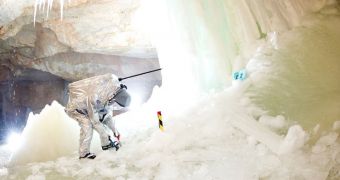The Eisriesenwelt labyrinth of caves, in the Dachstein region of Austria, was recently home to a series of studies meant to simulate the exploration of Mars. Such endeavors are essential for space exploration, since they teach us what to expect when traveling to our neighboring world.
The surface of the Red Planet is an extremely harsh and cold desert, bathed in radiations from the Sun, and the atmosphere does not do a whole lot to protect lifeforms on the ground. There are several places on Earth that replicate some of these conditions, and Alp caves are some of them.
In addition, many scientists are proposing Martian caves as potential sites for establishing a permanent human presence on the planet. If this plan is applied, astronauts need to become speleologists, and learn how to live and work underground.
In addition to providing steady climates, caves also protect dwellers from intense radiation. They may also be more humid than the bone-dry surface of Mars. Most of the water-ice is concentrated in ice caps at the poles, which are covered by a thin layer of dust.
The new experiments were organized by the Austrian Space Forum (ASF). Caves “would be a natural retreat for life, if it ever arose on Mars,” ASF president said astrobiologist Gernot Grömer explains.
But these locations also contain very varied terrain, and so experts wanted to learn how space exploration equipment could be handled in this environment. “The Dachstein Ice Caves offered nearly every terrain type we could think of on Mars,” Grömer adds.
A total of 11 countries on 3 continents participated in the exploration effort, which was led by the ASF and the NASA Jet Propulsion Laboratory (JPL), in Pasadena, California, Astrobiology Magazine reports. The caves are located about 1,300 meters (4,265 feet) above sea level.
“The Dachstein mission gave us a glimpse of what one day could become a part of history,” the ASF president says. All “astronauts” that took part in the research effort donned 45-kilogram (100-pound) Aouda.X space suits that are designed specifically to protect wearers from cold and radiations.
The suits also contributed to making the mission appear more real, since they caused diminished sensory perception in their users, and made them feel as if they were working under lower atmospheric pressure.

 14 DAY TRIAL //
14 DAY TRIAL //